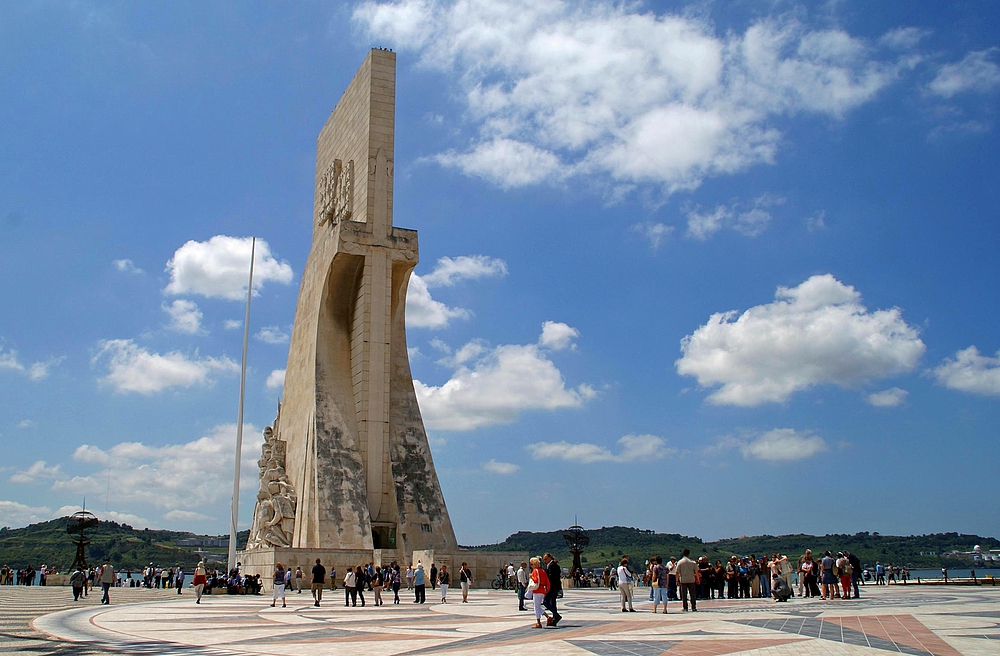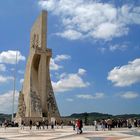Monument to the Discoveries
Entdeckerdenkmal
Das Entdeckerdenkmal wurde 1960 während der Feiern zum 500. Todestag des Infant D. Henrique (Heinrich der Seefahrer) eingeweiht. Es erinnert an die maritime Ausdehnung und hat die Form einer Karavelle. Es zeigt Heinrich den Seefahrer am Bug, der eine kleine Karavelle in der Hand hält, und weitere Helden der portugiesischen Geschichte (Vasca da Gama, Pedro Àlvares Cabral – der Entdecker Brasiliens – Fernão Magalhães – der in 1520 den Pazifik überquerte – den Schriftsteller Camões und viele andere).
Dieses Denkmal, betrachtet vom riesigen Kompass aus, fasziniert die Besucher mit seiner eindrucksvollen Größe von 50 m Höhe. Millionen von Leuten besuchen es jedes Jahr. Der Kompass, der in Pflasterstein gehauen wurde (sehen Sie obige Abbildung), war ein Geschenk der Republik von Südafrika in 1960, und man sieht ihn am besten von der Spitze des Entdeckerdenkmals, die man über einen Aufzug im Inneren des Gebäudes erreichen kann. Die in der Mitte liegende Landkarte, auf der Galeonen und Meerjungfrauen dargestellt werden, zeigt die Routen der Entdecker im 15. und 16. Jahrhundert.
Sie finden dieses Denkmal in Belém am Ufer des Flusses Tejo in einer einmaligen, imposanten Gegend und besonders in der Spätnachmittagssonne. sieht es sehr dramatisch aus.
Quelle: Strawberry World Lisbon
22.05.2012
Monument to the Discoveries
The Monument to the Discoveries was inaugurated in 1960 during celebrations of the 500 year anniversary of the death of the Infant D. Henrique (Henry the Navigator). It evoques the maritime expansion and is designed in the shape of a caravel, showing Henry the Navigator at the prow holding a small caravel, as well as many relevant heroes of Portuguese history (Vasco da Gama, Pedro Álvares Cabral - discoverer of Brazil - Fernão Magalhães - who crossed the Pacific in1520 -, the writer Camões and many others).
Seen from the huge mariners compass this monument fascinates visitors with its impressiveness and its 50 metres height. It is visited by millions of people each year. Cut into the paving stone, the compass (see panel above) was a present from the Republic of South Africa in 1960 and it's best seen from the top of the Monument to the Discoveries, that you can access by elevator located inside the building. The central map, depicting galleons and mermaids, shows the routes of the discoverers in the 15th and 16th centuries.
It is located in Belém, on the bank of the River Tagus, in an unique monumental area and looks particularly dramatic in the light of the late afternoon sun.
source: Strawberry World Lisbon










Peter Preis Dinslaken 07/06/2015 20:14
Top Aufnahme gefällt mir außerordentlich gut Lg.Pididieheide 27/07/2012 11:07
Traumhaft was Lissabon so zu bieten hat, wäre mal eine Reise wert.LG Heide
David H Thomas 24/07/2012 17:05
wonderful imageRainer Switala 24/07/2012 12:51
beeindruckendes motivbestens hier präsentiert
feine arbeit
gruß rainer
Inez Correia Marques 23/07/2012 19:47
Excellent !!!Dietmar Stegmann 23/07/2012 17:13
Schaut imposant aus, ich mag solche Denkmale aber nicht wirklich.VG Dietmar
LauraFlorence 23/07/2012 2:37
Eine sehr schöne Aufnahme, weil das Segel buchstäblich in den Himmel ragt .. klein drum herum die Menschen. Ein sehr beeindruckendes Monument, das durch den Himmel mit weißen Wölkchen an den heutigen Tag erinnert.LG Laura
Siegfried Duerschlag 22/07/2012 22:13
gut aufgenommenmit herrlichem Himmel
Gefällt mir sehr.
LG Siegfried
Adele D. Oliver 22/07/2012 20:11
so beautiful and fascinating this monument - I remember it well :-))) a very fine shot against the cloudy blue sky - and thank you for all the interesting information.a hug, Adele
Mafidi 22/07/2012 17:42
Ein gewaltiges, beachtliches Dokument der großen Seefahrerzeit - das war die große Zeit Portugals... Gut die Erklärung.LG Marion
roland gruss 22/07/2012 17:30
sehr gute infohabe wieder einiges gelernt
lg roland ;-)
Vitória Castelo Santos 22/07/2012 16:53
Hallo Albert, in einem herrlichen Licht, eine wunderbare Aufnahme !!LG Vitoria
BOLUS 22/07/2012 15:48
gefällt mir sehr gut, schöne kräftige Farben. klasse arbeit!VG BOLUS
schatz katharina 22/07/2012 15:11
Schön!!!LG Katharina
Keims-Ukas 22/07/2012 13:13
Prima Motiv in beeindrückender Größe. Schön das Umfeld mit aufgenommen, so kann man die Größe der Anlage besser einschätzen.Prima die klare Schärfe und schönen Farben.
LG, Uwe!